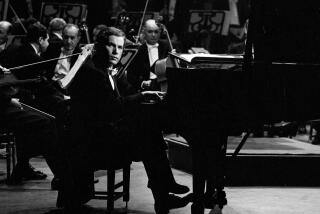The Reality of ‘Shine’: An Image Distorted
Like so many other music lovers, I have been following David Helfgott’s controversial recital tour with an increasing sense of foreboding. The Australian pianist whose triumph over mental illness is so inspirationally depicted in “Shine” will soon be in Los Angeles.
He is scheduled to make his local debut at the Dorothy Chandler Pavilion Tuesday in the first of four sold-out recitals here this month and next. A rumor--regularly floated and denied--has him performing at the Academy Awards ceremony Monday, since “Shine” is nominated for seven Oscars.
But even with the surprise announcement that Helfgott will perform the Rachmaninoff Third Piano Concerto at the Hollywood Bowl this summer, the shine is beginning to fade from “Shine.”
The initial reports from Boston, where Helfgott began the North American segment of his tour March 4, were disturbingly alike. Critics attested to a pianist whose technique had evidently suffered from years of neglect imposed by his treatment and whose concentration was equally unreliable.
This is exactly what Helfgott’s best-selling recording of the Rachmaninoff concerto and Second Sonata revealed months ago.
By the time Helfgott reached Lincoln Center last Tuesday, the New York Times had reported that “as hot tickets go, this one was lukewarm.” And more than a hint of impatience has started to enter into the reviews. Terry Teachout, in the New York Daily News, described Helfgott as “profoundly mentally ill.”
Of course, Helfgott’s devoted fans, who feel that competence is not the point, still love him, and he is apparently just as lovable in reality as the eccentric portrayed in the film. He runs on stage to perform. He impetuously hugs anyone within reach. He babbles self-help mantras to himself that show us how hard he is trying to keep focused.
But guileless as Helfgott surely is, guile surrounds him.
The veracity of his story as presented in the film has been called into question. Helfgott’s mother has charged that the portrayal of the pianist’s supposedly repressive father is a moral outrage. Helfgott did not, in fact, suffer a mental breakdown from the rigors of playing the Rachmaninoff Third while a conservatory student in London. It occurred years later, maybe in part because of an unhappy first marriage.
The director, Scott Hicks, and Helfgott’s second wife, Gillian--who is depicted in the film as Helfgott’s savior and who is knee-deep in the merchandising of her husband--continue to defend “Shine.”
They point to reasonable poetic license; they also say that Helfgott has authorized his celluloid depiction, although it remains unclear just how much he understands and how susceptible he is to their influence.
But the controversy over the biographical details is far less troubling than the fact that the whole Helfgott phenomenon, and especially the “Shine” tour, confuses personal accomplishment with artistic achievement.
It is clear that Helfgott never had the qualities necessary to become a great musician. He obviously couldn’t handle the stress that is as much a part of a concert pianist’s job as it is a heart surgeon’s or an airplane pilot’s or a U.S. president’s.
Worse, he never had a chance to evolve very far as a musician. His main ambition appears to have been the mastery of a popular showpiece that has some fiendishly difficult piano writing in it, some clever use of instrumental sonorities and some sure-to-please gushy melodies. It can certainly be an effective piece. Vladimir Horowitz made a great display out of it, as does Martha Argerich today, and there is nothing wrong with that. But great art it isn’t.
It’s as if Helfgott were an aspiring track star who fell apart trying to break the four-minute mile long after it had been broken. It is as if we are asked to celebrate him as a great athlete 30 years later simply because he can get himself around the track.
And then there’s the hint of artistic sour grapes. Things start looking bad for the young Helfgott in the film when he loses a provincial competition in Australia to a contemporary named Roger Woodward. The implication is that Woodward’s flashy playing is given unfair preference over Helfgott’s deeper, more original approach.
Just as there is a real Helfgott, there is a real Woodward, but unlike Helfgott’s, his is a story of artistic achievement. Rather than follow a career as a conventional virtuoso, as Helfgott seems to have wanted, let alone aspire to the show business career that Helfgott has achieved, Woodward has devoted himself to performing intense, spiritually penetrating new music. Toru Takemitsu, Morton Feldman and Iannis Xenakis are among the composers who have written important and memorable music for him.
I remember, for instance, hearing Woodward premiere a work for piano and orchestra by Xenakis with the New York Philharmonic 10 years ago. If the Rachmaninoff Third Piano Concerto is the Everest of music--as it is repeatedly called in “Shine”--then Xenakis’ “Keqrops” is the moon shot. The piano part is of a much higher order of difficulty, and where Rachmaninoff was content with sentiment and thunder, Xenakis attempts to reveal in tone and through advanced mathematical structures something of how the universe operates.
Woodward, for his efforts in the cause of music, was awarded the Order of the British Empire in 1980, but none of his recordings is in print. Helfgott, on the other hand, has sold more copies of his Rachmaninoff recording than any other classical release on his label, RCA, ever.
This means that a performance lacking in basic competence has outsold some of the greatest recordings of all time, by the likes of Horowitz, Heifetz, Rubinstein, Toscanini and Caruso.
That is not a proud statistic but a freak one. It means that reviewers are forced to put aside their sympathy for this pianist’s personal plight and judge him against standards that even the tour promoters say are inappropriate: They have requested that the press treat the concerts as a human interest story, not as a music story.
It means, I’m afraid, that Helfgott’s name can go down in history only as a believe-it-or-not factoid. It means that this pianist is certainly being abused, not only by the music business but also by the fans who love him.
More to Read
The biggest entertainment stories
Get our big stories about Hollywood, film, television, music, arts, culture and more right in your inbox as soon as they publish.
You may occasionally receive promotional content from the Los Angeles Times.











